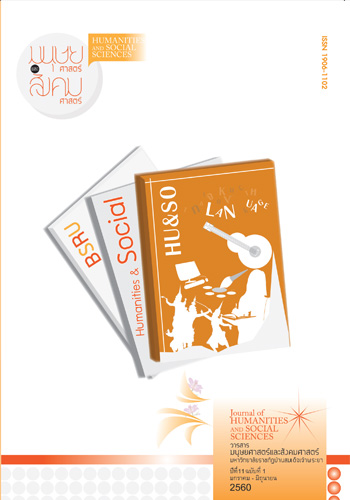The “Suang Huea” Tradition of Mekong Riverine Communities: Background and Revival after the Turning a Battlefield to a Market Place Policy
Keywords:
Suang Huea, Naga Worshiping Tradition, Mekong Riverine Communities, Boat Racing, Thai-Lao RelationshipAbstract
This research was aimed at investigating the traditional role of “Suang Huea” (boat racing) and its adaptation to accommodate the Thai government policy, “Turning a Battlefield to a Market Place”. The study was conducted by documentary research and field data collection in the communities located along the Mekong River in Mukdahan, Nakhon Phanom and Nong Khai provinces of Thailand.
The study shows that the “Suang Huea” tradition was originally a tradition of the Lan Xang kingdom. It was documented in “Heet Sibsong Khong Sibsii” that this tradition was performed to worship all 15 clans of Naga. There was very little information on this tradition documented during the Lan Xang period; however, much information was found during the period of King Suriwongsa Thammikaraj (B.E. 2185). According to the record of Van Wus Toff, Holland ambassador of trade, the evidence was found in the Champasak chronicle in the reign of King Soi Samut Bhutthangkoon (B.E. 2256) as well as in Mr. Deleporte’s painting “The Basin of Mekong River” recorded in B.E. 2410. Laos was under the Thai control for 114 years (B.E. 2322-2436) and subsequently under the French colony for 61 years (B.E 2436-2497). It was independent between B.E. 2497-2518, totally 21 years. During the period of political changes, no evidence on the “Suang Huea” tradition was found. Not until B.E. 2522, the Thai and Lao governments co-organized the “Suang Huea” tradition in Nong Khai province to foster good relation and especially to encourage the people of two countries to interact with each other in trade and economic developments. In B.E. 2531, the Thai government approved the policy to jointly organize this long-boat racing tradition as a means to enhance the Thai-Lao relationship among the communities located along the Mekong River in three provinces. Finally, the “Suang Huea” tradition has been organized and practiced by the locals of the two countries ever since.
References
กรมศิลปากร. (2506). ประชุมพงศาวดาร เล่ม 1 (ภาคที่ 1 และภาคที่ 2). พระนคร: ก้าวหน้า.
. (2512). ประชุมพงศาวดาร เล่ม 40, 43, 44, 45. กรุงเทพฯ : องค์การค้า คุรุสภา.
กระทรวงการต่างประเทศ และกระทรวงพาณิชย์. (2537). ลู่ทางขยายการค้าและการลุงทุนของประเทศไทยกับประเทศสาธารณรัฐประชาธิปไตยประชาชนลาว. กรุงเทพฯ : ปฤษฐธุรกิจ.
กระทรวงมหาดไทย, กระทรวงศึกษาธิการ, และกรมศิลปากร. (2542ก). วัฒนธรรมพัฒนาการทางประวัติศาสตร์ เอกลักษณ์และภูมิปัญญา จังหวัดนครพนม. กรุงเทพฯ : คุรุสภาลาดพร้าว.
กระทรวงมหาดไทย, กระทรวงศึกษาธิการ, และกรมศิลปากร. (2542ข). วัฒนธรรม พัฒนาการทางประวัติศาสตร์ เอกลักษณ์และภูมิปัญญา จังหวัดมุกดาหาร. กรุงเทพฯ : คุรุสภาลาดพร้าว.
กระทรวงมหาดไทย, กระทรวงศึกษาธิการ, และกรมศิลปากร. (2542ค). วัฒนธรรม พัฒนาการทางประวัติศาสตร์ เอกลักษณ์และภูมิปัญญา จังหวัดหนองคาย. กรุงเทพฯ : คุรุสภาลาดพร้าว.
จันดา อุดามาลย์. ร่างทรงเจ้าแม่สองนาง. (สัมภาษณ์, 8 กรกฎาคม 2560).
จารุบุตร เรืองสุวรรณ. (2528). เรื่องฮีตสิบสอง-คองสิบสี่ ระบบการปกครองของชาวลาวและอีสานสมัยเก่า. ใน มูลมรดกชนชาติอ้ายลาว. อนุสรณ์งานพระราชทานเพลิงศพ สมเด็จพระยอดแก้วพุทธชิโนรสสกลมหาสังฆปาโมกข์ สมเด็จพระสังฆราชแห่งพระราชอาณาจักรลาว ณ เมรุหลวงหน้าพลับพลาอิศริยาภรณ์ วัดเทพศิรินทราวาส กรุงเทพมหานคร 12 มีนาคม 2528.
จารุวรรณ ธรรมวัตร. (ม.ป.ป.) ฉบับปริวรรติ, 56-64.
ดวงมณี เพชรสุวรรณรังสี. (2551). แนวทางการบริหารจัดการประเพณีการแข่งเรือสองฝั่งโขงเพื่อส่งเสริมการท่องเที่ยวทางวัฒนธรรม. วิทยานิพนธ์วัฒนธรรมศาสตร์มหาบัณฑิต สาขาวิชาวัฒนธรรมศาสตร์ มหาวิทยาลัยมหาสารคาม.
เติม วิภาคย์พจนกิจ. (2546). ประวัติศาสตร์อีสาน. (พิมพ์ครั้งที่ 4). กรุงเทพฯ : สำนักพิมพ์มหาวิทยาลัยธรรมศาสตร์.
เถาะ เหงียนถิ. ร่างทรงเจ้าแม่สองนาง. (สัมภาษณ์, 9 กรกฎาคม 2560).
ทองสมุทร โดเร และสมหมาย เปรมจิตต์. (2539). บันทึกการเดินทางในลาว ภาคหนึ่ง พ.ศ. 2438. เชียงใหม่ : โครงการผลิตเอกสารส่งเสริมความรู้เกี่ยวกับประเทศเพื่อนบ้าน สถาบันวิจัยสังคม มหาวิทยาลัยเชียงใหม่ ทบวงมหาวิทยาลัย.
ประภัทร์ สวัสดิ์วงศ์ไชย. ชาวจังหวัดมุกดาหาร. (สัมภาษณ์, 27 ตุลาคม 2555).
พิชญ์ สมพอง. (2542). ส่วงเฮือ. ใน สารานุกรมวัฒนธรรมไทย ภาคอีสาน. เล่ม 13. (น. ๔๔๓๕) . กรุงเทพฯ : มูลนิธิสารานุกรมวัฒนธรรมไทย ธนาคารไทยพาณิชย์.
มานะ มาลาเพชร. (2537). การค้าชายแดนไทย-ลาว : ปัญหาและทิศทางการค้าชายแดน. กรุงเทพฯ : สถาบันเชียศึกษา จุฬาลงกรณ์มหาวิทยาลัย.
วิมลพรรณ ปีตธวัชชัย. (2548). ฮีตสิบสอง. กรุงเทพฯ : องค์การค้าคุรุสภา.
สมศักดิ์ ศรีวรรธนะ. (2534). นโยบายการเปลี่ยนสนามรบเป็นสนามการค้าบทวิเคราะห์ ด้านจิตวิทยา ศึกษาเฉพาะกรณีสาธารณรัฐประชาธิปไตยประชาชนลาว.
กรุงเทพฯ : กรมการปกครอง.
สมหมาย เปรมจิตต์ (ผู้แปล). (2539). ประวัติศาสตร์ลาว. กรุงเทพฯ : มติชน.
สีลา วีระวงศ์. (2530). ฮีตสิบสอง. อุบลราชธานี : ศูนย์ศิลปวัฒนธรรมวิทยาลัยครูอุบลราชธานี.
สุกัญญา สุจฉายา (ผู้ถ่ายภาพ). ( 2560). ภาพการแข่งเรือ บริเวณท่าน้ำวัดเชียงแมนที่หลวงพระบาง.
สุกัญญา สุจฉายา. นักวิจัยประจำศูนย์สยามทรรศน์ศึกษา. (สัมภาษณ์, 5 กรกฎาคม 2560)
สุวิทย์ ธีรศาศวัต. (2543). ประวัติศาสตร์ลาว. กรุงเทพฯ : สร้างสรรค์.
อรวรรณ เชื้อหาญ. ชาวจังหวัดมุกดาหาร. (สัมภาษณ์, 27 ตุลาคม 2555).
Pavie, A. (1999). Travel Report of the Pavie Mission. Bangkok : White Lotus.
Downloads
Published
How to Cite
Issue
Section
License

This work is licensed under a Creative Commons Attribution-NonCommercial-NoDerivatives 4.0 International License.




